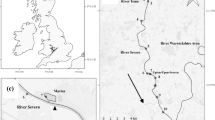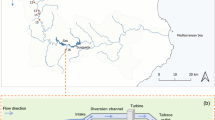Abstract
The zonation of mobile species, such as grazing snails, may be influenced by migration patterns, which often are missed if the population is not sampled within the appropriate temporal scales (i.e., tidal cycles, diurnal periods, seasons). Aspects of community ecology, especially abundance, biodiversity, and habitat preferences, are better described when the mobility of different species or group of organisms also are investigated. The effect of migration on the density and size-frequency distribution of a dominant intertidal grazer (Turbo smaragdus) was investigated across four habitats (mangrove tree, pneumatophore, algal aggregation, and seagrass bed) during emersion and immersion periods at Matapouri Estuary, northern New Zealand, in August 2004 and March 2005. Snails were marked and recaptured to identify their specific movements across the four zones during high and low tide periods. Results from the population surveys and the marked-recaptured experiments indicate that snails migrate upward during high tide and do wnward during low tide. These snail movements appear to be related to improved feeding activity during tidal inundation within macroalgal aggregations in the pneumatophore and algal zones. Large snails (up to 48 mm in width) were predominant in the highest zone among the mangrove trees, where they appear to feed on filamentous algae and microalgae that cover the sediment and plant surfaces in this area. Differences in snail density and sizes between the two sampling months were attributed to reproductive patterns of this species, which result in about 30% more snails (mostly juveniles) during peak reproduction in March.
Similar content being viewed by others
Literature Cited
Albrecht, A. S. 1998. Soft bottom versus hard rock: Community ecology of macroalgae on intertidal mussel beds in the Wadden Sea.Journal of Experimental Marine Biology and Ecology 229:85–109.
Alfaro, A. C. 2006. Benthic macro-invertebrate community composition within, a mangrove/seagrass estuary in northern New Zealand.Estuarine Coastal and Shelf Science 66:97–110.
Chapman, M. G. andA. J. Underwood. 1994. Dispersal of the intertidal snail,Nodilittorina pyramidalis, in response to the topographic complexity of the substratum.Journal of Experimental Marine Biology and Ecology 179:145–169.
Cresse, R. G. 1988. Ecology of molluscan grazers and their interactions with marine algae in north-eastern New Zealand: A review.New Zealand of Marine and Freshwater Research 22:427–444.
Crowe, T. P. andA. J. Underwood. 1999. Differences in dispersal of an intertidal gastropod in two habitats: The need for and design of repeated experimental transplantation.Journal of Experimental Marine Biology and Ecology 237:31–60.
Davidson, I. C., A. C. Crooks, andD. K. A. Barnes. 2004. Macrobenthic migration and its influence on the intertidal diversity dynamics of a meso-tidal system.Marine Biology 145:833–842.
Edwards, M. F. 1982. Gastropod-algal interactions in the intertidal region. M.Sc. Thesis, University of Auckland, Auckland, New Zealand.
Grange, K. R. 1974. Population structure, breeding cycles and larval development in some trochid and turbinid gastropods. M.Sc. Thesis, University of Auckland, Auckland, New Zealand.
Hume, T. M. andC. E. Herdendorf. 1988. A geographic classification of estuaries and its application to coastal resource management: A New Zealand example.Ocean and Shoreline Management 11:249–274.
Hutchinson, N. andG. A. Williams. 2003. An assessment of variation in molluscan grazing pressure on Hong Kong rocky shores.Marine Biology 142:495–507.
Ingolfsson, A. andI. Agnarsson. 2003. Amphipods and isopods in the rocky intertidal: Dispersal and movements during high tide.Marine Biology 143:859–866.
Kanamori, M., S. Goshima, andH. Mukai. 2004. Seasonal variation in host utilization of epiphyticLacuna species in mixed algal and surfgrass stands in Japan.Marine Ecology 25:51–69.
Levings, S. C. andS. D. Garrity. 1983. Diel and tidal movement of two co-occurring neritidal snails: Differences in grazing patterns on a tropical rocky shore.Journal of Experimental Marine Biology and Ecology 67:261–278.
Nickel, L. A. andM. D. J. Sayer. 1998. Occurrence and activity of mobile macrofauna on a sublittoral reef: Diel and seasonal variation.Journal of the Marine Biological Association, U.K. 78:1061–1082.
Pardo, L. M. andL. E. Johnson. 2004. Activity and shelter, use of an intertidal snail: Effects of sex, reproductive condition and tidal cycle.Journal of Experimental Marine Biology and Ecology 301:175–191.
Price, C. H. 1984. Tidal migrations of the littoral salt marsh snailMelampus bidentalus Say.Journal of Experimental Marine Biology and Ecology 78:111–126.
Robinson, L. 1992. Population and reproductive ecology ofTurbo smaragdus in the Kaikoura region M. Sc. Thesis, Department of Zoology, University of Canterbury, Canterbury, New Zealand.
Rochette, R. andL. M. Dill. 2000. Mortality, behavior and the effects of predators on the intertidal distribution of littorinid gastropods.Journal of Experimental Marine Biology and Ecology 253:165–191.
Town, J. C. 1980. Diet and food preference of intertidalAstrostole scabra (Asteroidea: Forcipulata).New Zealand Journal of Marine and Freshwater Research 14:427–435.
Town, J. C. 1981. Prey characteristics and dietary composition in intertidalAstrostole scabra (Echinodermata: Asteroidea).New Zealand Journal of Marine and Freshwater Research 15:69–80.
Walker, N. 1998. Grazing in the intertidal zone: Effects of the herbivorousTurbo smaragdus on macroalgae assemblages M.Sc. Thesis, Department of Zoology, University of Canterbury, Canterbury, New Zealand.
Walsby, J. R. 1977. Population variations in the grazing turbinidLunella smaragda (Mollusca: Gastropoda).New Zealand Journal of Marine and Freshwater Research 11:211–238.
Worthington, D. G. andP. G. Fairweather. 1989. Shelter and food: Interactions betweenTurbo undulatum (Archaeogastropoda: Turbinidae) and coralline algae on rocky seashores in New South Wales.Journal of Experimental Marine Biology and Ecology 129:61–79.
Yamada, S. B., S. A. Navarrete, andC. Needham. 1998. Predation induced changes in behavior and growth rate in three populations of the intertidal snail,Littorina sitkana (Philippi).Journal of Experimental Marine Biology and Ecology 220:213–226.
Author information
Authors and Affiliations
Corresponding author
Rights and permissions
About this article
Cite this article
Alfaro, A.C. Tidal migration influences the zonation of grazing snails (Turbo smaragdus) in a mangrove-seagrass estuary, Northern New Zealand. Estuaries and Coasts: J ERF 29, 731–736 (2006). https://doi.org/10.1007/BF02786524
Received:
Revised:
Accepted:
Issue Date:
DOI: https://doi.org/10.1007/BF02786524




